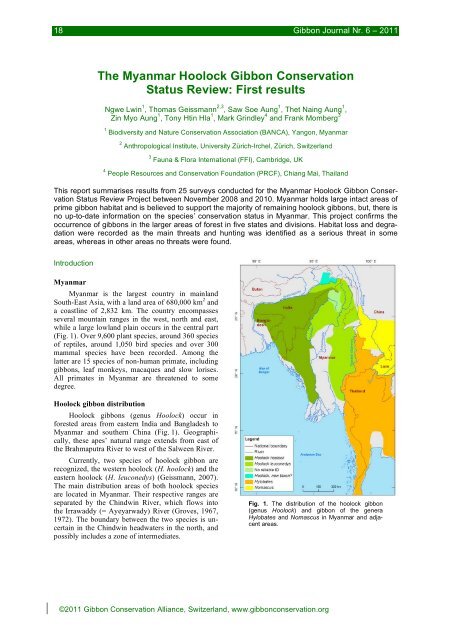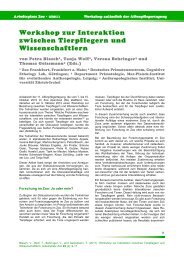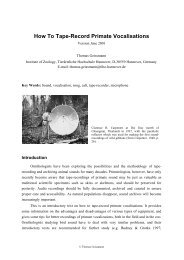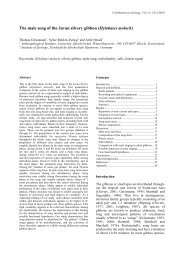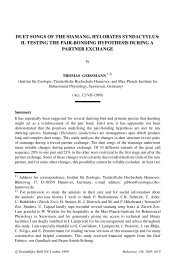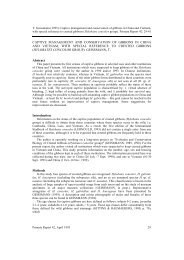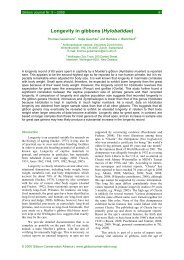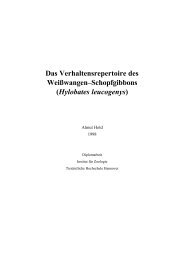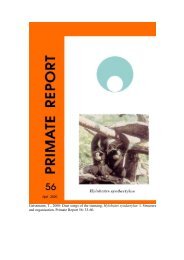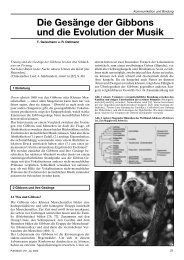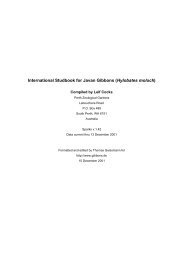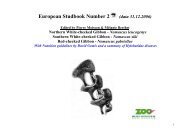The Myanmar Hoolock Gibbon Conservation Status Review: First ...
The Myanmar Hoolock Gibbon Conservation Status Review: First ...
The Myanmar Hoolock Gibbon Conservation Status Review: First ...
Create successful ePaper yourself
Turn your PDF publications into a flip-book with our unique Google optimized e-Paper software.
18 <strong>Gibbon</strong> Journal Nr. 6 – 2011<br />
<strong>The</strong> <strong>Myanmar</strong> <strong>Hoolock</strong> <strong>Gibbon</strong> <strong>Conservation</strong><br />
<strong>Status</strong> <strong>Review</strong>: <strong>First</strong> results<br />
Ngwe Lwin 1 , Thomas Geissmann 2,3 , Saw Soe Aung 1 , <strong>The</strong>t Naing Aung 1 ,<br />
Zin Myo Aung 1 , Tony Htin Hla 1 , Mark Grindley 4 and Frank Momberg 3<br />
1 Biodiversity and Nature <strong>Conservation</strong> Association (BANCA), Yangon, <strong>Myanmar</strong><br />
2 Anthropological Institute, University Zürich-Irchel, Zürich, Switzerland<br />
3 Fauna & Flora International (FFI), Cambridge, UK<br />
4 People Resources and <strong>Conservation</strong> Foundation (PRCF), Chiang Mai, Thailand<br />
This report summarises results from 25 surveys conducted for the <strong>Myanmar</strong> <strong>Hoolock</strong> <strong>Gibbon</strong> <strong>Conservation</strong><br />
<strong>Status</strong> <strong>Review</strong> Project between November 2008 and 2010. <strong>Myanmar</strong> holds large intact areas of<br />
prime gibbon habitat and is believed to support the majority of remaining hoolock gibbons, but, there is<br />
no up-to-date information on the species’ conservation status in <strong>Myanmar</strong>. This project confirms the<br />
occurrence of gibbons in the larger areas of forest in five states and divisions. Habitat loss and degradation<br />
were recorded as the main threats and hunting was identified as a serious threat in some<br />
areas, whereas in other areas no threats were found.<br />
Introduction<br />
<strong>Myanmar</strong><br />
<strong>Myanmar</strong> is the largest country in mainland<br />
South-East Asia, with a land area of 680,000 km 2 and<br />
a coastline of 2,832 km. <strong>The</strong> country encompasses<br />
several mountain ranges in the west, north and east,<br />
while a large lowland plain occurs in the central part<br />
(Fig. 1). Over 9,600 plant species, around 360 species<br />
of reptiles, around 1,050 bird species and over 300<br />
mammal species have been recorded. Among the<br />
latter are 15 species of non-human primate, including<br />
gibbons, leaf monkeys, macaques and slow lorises.<br />
All primates in <strong>Myanmar</strong> are threatened to some<br />
degree.<br />
<strong>Hoolock</strong> gibbon distribution<br />
<strong>Hoolock</strong> gibbons (genus <strong>Hoolock</strong>) occur in<br />
forested areas from eastern India and Bangladesh to<br />
<strong>Myanmar</strong> and southern China (Fig. 1). Geographically,<br />
these apes’ natural range extends from east of<br />
the Brahmaputra River to west of the Salween River.<br />
Currently, two species of hoolock gibbon are<br />
recognized, the western hoolock (H. hoolock) and the<br />
eastern hoolock (H. leuconedys) (Geissmann, 2007).<br />
<strong>The</strong> main distribution areas of both hoolock species<br />
are located in <strong>Myanmar</strong>. <strong>The</strong>ir respective ranges are<br />
separated by the Chindwin River, which flows into<br />
the Irrawaddy (= Ayeyarwady) River (Groves, 1967,<br />
1972). <strong>The</strong> boundary between the two species is uncertain<br />
in the Chindwin headwaters in the north, and<br />
possibly includes a zone of intermediates.<br />
Fig. 1. <strong>The</strong> distribution of the hoolock gibbon<br />
(genus <strong>Hoolock</strong>) and gibbon of the genera<br />
Hylobates and Nomascus in <strong>Myanmar</strong> and adjacent<br />
areas.<br />
© ©2011 <strong>Gibbon</strong> <strong>Gibbon</strong> <strong>Conservation</strong> Alliance Alliance, ( www.gibbonconservation.org)<br />
Switzerland, www.gibbonconservation.org
<strong>Gibbon</strong> Journal Nr. 6 – 2011 19<br />
<strong>Hoolock</strong> <strong>Gibbon</strong> <strong>Conservation</strong> <strong>Status</strong> <strong>Review</strong><br />
Project<br />
This project is jointly implemented by the Biodiversity<br />
and Nature <strong>Conservation</strong> Association<br />
(BANCA), Fauna & Flora International (FFI) and the<br />
People Resources and <strong>Conservation</strong> Foundation<br />
(PRCF).<br />
<strong>The</strong> project aims to assess the conservation<br />
status of the hoolock gibbons in <strong>Myanmar</strong>, while<br />
strengthening the capacity of the conservation movement<br />
in primate surveying, monitoring and conservation<br />
in <strong>Myanmar</strong>.<br />
Three main objectives are (1) increase<br />
knowledge of the distribution and relative abundance<br />
of hoolock gibbons in <strong>Myanmar</strong>, (2) identify major<br />
threats to gibbons in <strong>Myanmar</strong> and (3) raise awareness<br />
among relevant stakeholders about gibbon conservation.<br />
Methods<br />
Activities<br />
A training and capacity building workshop was<br />
conducted at the beginning of the project in 2008.<br />
<strong>The</strong> participants included lecturers and students from<br />
Yangon University, Western Yangon University,<br />
Pyay University and Dawei University, and local<br />
NGO staff from BANCA and Rakhine Coastal Association<br />
(RCA).<br />
After the training workshop, field surveys were<br />
conducted in five states and divisions from December<br />
2008 to May 2010. A workshop on the results of the<br />
conservation status review and on conservation action<br />
planning was held in May and June 2010.<br />
Priority survey sites<br />
Priority areas for the field survey sites were selected<br />
based on the forest cover maps of <strong>Myanmar</strong><br />
(Stibig, 2003, 2004). A total of 14 areas were chosen<br />
as targets for hoolock gibbon field surveys.<br />
Field surveys<br />
A total of 25 field surveys were conducted from<br />
December 2008 to May 2010 in five states and divisions.<br />
Nine field surveys were conducted in the distribution<br />
area of the western hoolock gibbon, including<br />
Naga Land and areas along the Rakhine Mountain<br />
Range, and sixteen field surveys were conducted in<br />
the distribution area of the eastern hoolock gibbon,<br />
including areas in northern and southern Kachin State<br />
and in Kayin State (Geissmann et al., 2008, 2009, in<br />
prep.; Lwin et al., 2010a, b; ).<br />
Survey method<br />
Field survey techniques most suitable to estimate<br />
densities of gibbons are variants of the Fixed Point<br />
Method, during which the loud morning songs of the<br />
gibbons are monitored simultaneously from four<br />
fixed listening points per site (Brockelman and Ali,<br />
1987; Brockelman and Srikosamatara, 1993).<br />
Listening posts were about 400 m apart and located<br />
on hilltops, in order to enable the survey participants<br />
to hear gibbons from as many directions as<br />
possible. Monitoring gibbon calls was carried out<br />
from dawn to noon for five consecutive days at each<br />
listening post.<br />
Each listening post was manned by one to two<br />
surveyors. Time, direction, estimated distance, and<br />
type of all gibbon songs were recorded on a field<br />
form. Song types included (1) solo song bouts, (2)<br />
duets with just two participants, (3) duets with more<br />
than two participants, and (4) duets involving an unknown<br />
number of participants.<br />
All information from each day were plotted and<br />
triangulated on graph paper. Density of gibbon<br />
groups was estimated based on the triangulated<br />
results.<br />
Although songs of wild gibbons can often be<br />
heard over distances greater than 1 km, gibbons<br />
singing behind hills are often estimated to be further<br />
away than 1 km. Furthermore, different gibbon<br />
groups beyond 600 m from the listener are more difficult<br />
to be distinguished than groups singing at closer<br />
distances. As a result, gibbon densities were estimated<br />
using both a 0.6 km and a 1 km listening radius.<br />
Results<br />
Group densities<br />
Group densities were estimated for 25 study<br />
areas. <strong>The</strong> lowest density was 0.13 group/km 2 and the<br />
highest density was 3.76 group/km 2 for western<br />
hoolock gibbon. <strong>The</strong> corresponding densities found<br />
for the eastern hoolock gibbon were 0.56 group/km 2<br />
and 7.07 group/km 2 , respectively.<br />
Preliminary estimates of gibbon group densities<br />
are summarized in Table 1.<br />
Threats to gibbons<br />
<strong>The</strong> results of 25 field surveys confirmed that<br />
habitat loss and degradation caused by shifting cultivation<br />
and timber extraction are the main threats to<br />
both gibbon species (Table 2). Hunting for trade and<br />
subsistence was also recorded as a serious threat in<br />
seven study areas in the distribution area of eastern<br />
hoolock gibbon. In six study areas, no threat to<br />
gibbons was detected.
20 <strong>Gibbon</strong> Journal Nr. 6 – 2011<br />
Species<br />
Table 1. <strong>Gibbon</strong> group density (mean ± standard deviation)<br />
Number of<br />
sites<br />
<strong>Gibbon</strong> group density/km 2<br />
Listening radius<br />
600 m 1 km<br />
H. hoolock 9 2.27±1.44 1.55±0.95<br />
H. leuconedys (also including Mahamyaing WS,<br />
Brockelman et al., 2005, 2009)<br />
17 2.63±1.76 2.05±0.98<br />
<strong>Hoolock</strong> sp., Hukaung valley (Saw Htun et al., 2006) 13 2.15±1.28 1.90±0.91<br />
Total 27 2.49±1.61 1.88±0.96<br />
Table 2. Threats to gibbons<br />
Species Major threats Minor threat No threat<br />
Habitat<br />
fragmentation<br />
Habitat<br />
degradation<br />
Hunting<br />
Hunting<br />
H. hoolock (9 sites) 8 (89%) – – 2 (22%) 1 (11%)<br />
H. leuconedys (16 sites) 4 (25%) 4 (25%) 7 (43%) – 5 (31%)<br />
<strong>Hoolock</strong> locality records<br />
<strong>Gibbon</strong> survey data from <strong>Myanmar</strong> can be<br />
roughly grouped into three time periods: historical<br />
records (before 1960), modern records (1980-2004)<br />
and recent records (2005-2010). A total of 148<br />
hoolock gibbon locality records were recorded in ten<br />
states and divisions. For the western hoolock gibbon,<br />
fifteen historical, 15 modern and 22 recent localities<br />
were recorded. For the eastern hoolock gibbon, the<br />
corresponding numbers were 35 historical, 12 modern<br />
and 44 recent localities. Only two modern and three<br />
recent localities were recorded for <strong>Hoolock</strong> sp. (Fig.<br />
2).<br />
Sixty-two (42%) of 148 localities were recorded<br />
from the status review project and 86 localities were<br />
recorded from the other sources.<br />
Action plan from the status review workshop<br />
A hoolock gibbon status review workshop was<br />
held on 25 June 2010, during which actions for<br />
hoolock gibbon conservation, research and transboundary<br />
activities were planned. Planned activities<br />
for the hoolock gibbon conservation include conducting<br />
a national-level awareness program, reviewing<br />
the <strong>Myanmar</strong> protected species list, raising legal<br />
awareness among stakeholders and reviewing the<br />
protected area system to strengthen gibbon conservation.<br />
Planned research activities include conducting<br />
additional field surveys, conducting long-term behavioural<br />
research/ecology studies and establishing<br />
monitoring at selected sites. Planned transboundary<br />
conservation activities include improving cooperation<br />
with China.<br />
Fig. 2. <strong>Hoolock</strong> gibbon locality records in<br />
<strong>Myanmar</strong>.<br />
Conclusions<br />
Although hoolock gibbon surveys were conducted<br />
in some areas of <strong>Myanmar</strong> prior to the<br />
<strong>Hoolock</strong> <strong>Gibbon</strong> <strong>Conservation</strong> <strong>Status</strong> <strong>Review</strong> Project,<br />
this project is the first nationwide hoolock gibbon<br />
status review. During its course, 25 field surveys<br />
were conducted in five states and divisions covering<br />
most of the hoolock gibbons’ main distribution areas.
<strong>Gibbon</strong> Journal Nr. 6 – 2011 21<br />
This project estimates the density of hoolock<br />
gibbons in <strong>Myanmar</strong> and confirms the conservation<br />
status of these apes in <strong>Myanmar</strong>. A conservation<br />
action plan was also designated for future activities.<br />
More field surveys will be conducted in two protected<br />
areas and a site-based conservation program will be<br />
established at one protected area.<br />
Acknowledgements<br />
We thank Arcus Foundation Great Apes Program,<br />
the United States Fish and Wildlife Service,<br />
Great Apes <strong>Conservation</strong> Fund, and <strong>Gibbon</strong> <strong>Conservation</strong><br />
Alliance for financial support for this project.<br />
<strong>The</strong> use of US grant funds in <strong>Myanmar</strong> for this<br />
project is authorised by the US Treasury Department’s<br />
Office of Foreign Assets Control.<br />
References<br />
Brockelman, W. Y. (2005). <strong>Conservation</strong> of the<br />
hoolock gibbon (Hylobates hoolock leuconedys)<br />
in Mahamyaing Wildlife Sanctuary, Sagaing<br />
division, <strong>Myanmar</strong>. Forest Department and Wildlife<br />
<strong>Conservation</strong> Society, <strong>Myanmar</strong> Program,<br />
Yangon, 20 pp.<br />
Brockelman, W. Y., Hla Nain, Chit Saw, Aung Moe,<br />
Zaw Linn, Thu Kyaw Moe, and Zaw Win. (2009).<br />
Census of eastern hoolock gibbons (<strong>Hoolock</strong><br />
leuconedys) in Mahamyaing Wildlife Sanctuary,<br />
Sagaing Division, <strong>Myanmar</strong>. In Lappan, S., and<br />
Whittacker, D. J. (eds.) <strong>The</strong> gibbons: New perspectives<br />
on small ape socioecology and population<br />
biology, Springer, New York, pp. 435-451.<br />
Brockelman, W. Y., and Ali, R. (1987). Methods of<br />
surveying and sampling forest primate populations.<br />
In Marsh, C. W., and Mittermeier, R. A.<br />
(eds.), Primate conservation in the tropical rain<br />
forest, Alan R. Liss, Inc., New York, pp. 23-62.<br />
Brockelman, W. Y., and Srikosamatara, S. (1993).<br />
Estimation of density of gibbon groups by use of<br />
loud songs. American Journal of Primatology 29:<br />
93-108.<br />
Geissmann, T. (2007). <strong>Status</strong> reassessment of the<br />
gibbons: Results of the Asian Primate Red List<br />
Workshop 2006. <strong>Gibbon</strong> Journal 3: 5-15.<br />
Geissmann, T., Grindley, M., Momberg, F., Lwin, N.,<br />
and Moses, S. (2008). <strong>Hoolock</strong> gibbon and biodiversity<br />
survey and training in southern Rakhine<br />
Yoma, <strong>Myanmar</strong>: Preliminary report, <strong>Myanmar</strong><br />
Primate <strong>Conservation</strong> Program, BANCA, FFI,<br />
PRCF and Yangon University, Yangon,<br />
<strong>Myanmar</strong>, 31 pp.<br />
Geissmann, T., Grindley, M., Momberg, F., Lwin, N.,<br />
and Moses, S. (2009). <strong>Hoolock</strong> gibbon and biodiversity<br />
survey and training in southern Rakhine<br />
Yoma, <strong>Myanmar</strong>. <strong>Gibbon</strong> Journal 5: 7-27.<br />
Geissmann, T., Grindley, M., Momberg, F., Lwin, N.,<br />
Aung, S. S., Aung, T. N., Zaw, S. M., Brown, S.,<br />
and Lu, Y. (in preparation). <strong>Hoolock</strong> gibbon and<br />
biodiversity survey in the Saw Law area, eastcentral<br />
Kachin state: preliminary report.<br />
<strong>Myanmar</strong> Primate <strong>Conservation</strong> Program Report<br />
No. 3. People Resources and <strong>Conservation</strong> Foundation<br />
(PRCF), Fauna &Flora International (FFI),<br />
and Biodiversity and Nature <strong>Conservation</strong> Association<br />
(BANCA), Yangon, 32 pp.<br />
Groves, C. P. (1967). Geographic variation in the<br />
hoolock or white-browed gibbon (Hylobates<br />
hoolock Harlan 1834). Folia Primatologica 7:<br />
276-283.<br />
Groves, C. P. (1972). Systematics and phylogeny of<br />
gibbons. In Rumbaugh, D. M. (ed.) <strong>Gibbon</strong> and<br />
siamang, vol. 1, Karger, Basel and New York, pp.<br />
1-89.<br />
Lwin, N., Moses, S., Aung, S. S., Aung, T. N.,<br />
Khaing, K. T., Grindley, M., and Geissmann, T.<br />
(2010a). <strong>Hoolock</strong> gibbon and biodiversity survey<br />
in central and southern Rakhine Yoma, <strong>Myanmar</strong>:<br />
preliminary report. <strong>Myanmar</strong> Primate <strong>Conservation</strong><br />
Program Report No. 2. People Resources and<br />
<strong>Conservation</strong> Foundation (PRCF), Fauna & Flora<br />
International (FFI), and Biodiversity and Nature<br />
<strong>Conservation</strong> Association (BANCA), Yangon, 33<br />
pp.<br />
Lwin, N., Aung, S. S., Aung, T. N., Grindley, M., and<br />
Geissmann, T. (2010b). <strong>Hoolock</strong> gibbon and biodiversity<br />
survey in middle and upper Mali Hka<br />
watershed area, northern Kachin State: Preliminary<br />
report. <strong>Myanmar</strong> Primate <strong>Conservation</strong><br />
Program Report No. 4. People Resources and<br />
<strong>Conservation</strong> Foundation (PRCF), Fauna & Flora<br />
International (FFI), and Biodiversity and Nature<br />
<strong>Conservation</strong> Association (BANCA), Yangon,<br />
33 pp.<br />
Saw Htun, Zaw Htoo Aung, Win Naing, Zaw Win<br />
Khaing, <strong>The</strong>in Htay, Nay Lin Tun, Aung Lwin,<br />
and Thu Kyaw Moe. (2006). Final Report on conservation<br />
of the hoolock gibbon (Hylobates<br />
hoolock) in the Hukaung Tiger Reserve, north<br />
<strong>Myanmar</strong>: Population surveys, threat assessment<br />
and conservation outreach, September 2006,<br />
Forest Department, Nature and Wildlife <strong>Conservation</strong><br />
Division, and Wildlife <strong>Conservation</strong><br />
Society – <strong>Myanmar</strong> Program, Yangon, 39 pp.<br />
Stibig, H.-J., and Beuchle, R. (2003). Forest cover<br />
map of continental Southeast Asia at 1:4 000 000<br />
derived from SPOT4-VEGETATION satellite<br />
images. Publications of the European Communities,<br />
EUR 20856, EN, 30 pp.<br />
Stibig, H.-J., Achard, F., and Fritz, S. (2004). A forest<br />
cover map of continental Southeast Asia derived<br />
from SPOT-VEGETATION satellite imagery.<br />
Applied Vegetation Science 7: 153-162.


